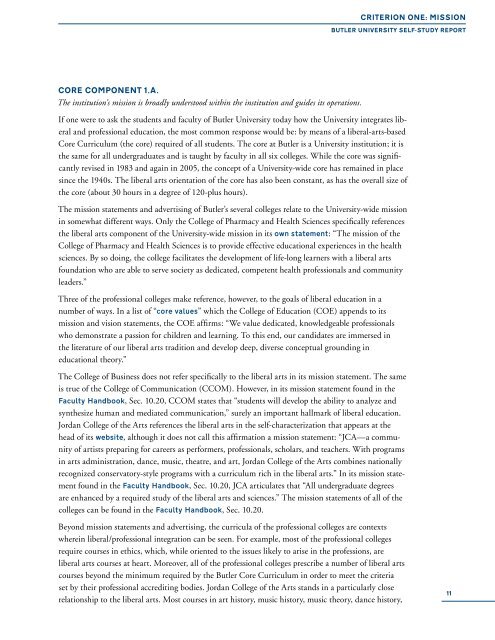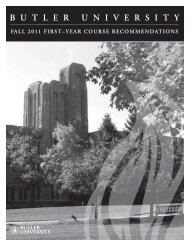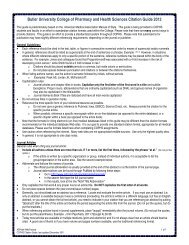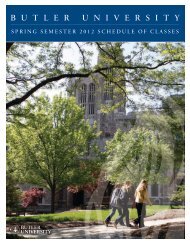Untitled - Show Answer - Butler University
Untitled - Show Answer - Butler University
Untitled - Show Answer - Butler University
Create successful ePaper yourself
Turn your PDF publications into a flip-book with our unique Google optimized e-Paper software.
CRITERION ONE: MISSION<br />
BUTLER UNIVERSITY SELF-STUDY REPORT<br />
Core Component 1.A.<br />
The institution’s mission is broadly understood within the institution and guides its operations.<br />
If one were to ask the students and faculty of <strong>Butler</strong> <strong>University</strong> today how the <strong>University</strong> integrates liberal<br />
and professional education, the most common response would be: by means of a liberal-arts-based<br />
Core Curriculum (the core) required of all students. The core at <strong>Butler</strong> is a <strong>University</strong> institution; it is<br />
the same for all undergraduates and is taught by faculty in all six colleges. While the core was significantly<br />
revised in 1983 and again in 2005, the concept of a <strong>University</strong>-wide core has remained in place<br />
since the 1940s. The liberal arts orientation of the core has also been constant, as has the overall size of<br />
the core (about 30 hours in a degree of 120-plus hours).<br />
The mission statements and advertising of <strong>Butler</strong>’s several colleges relate to the <strong>University</strong>-wide mission<br />
in somewhat different ways. Only the College of Pharmacy and Health Sciences specifically references<br />
the liberal arts component of the <strong>University</strong>-wide mission in its own statement: “The mission of the<br />
College of Pharmacy and Health Sciences is to provide effective educational experiences in the health<br />
sciences. By so doing, the college facilitates the development of life-long learners with a liberal arts<br />
foundation who are able to serve society as dedicated, competent health professionals and community<br />
leaders.”<br />
Three of the professional colleges make reference, however, to the goals of liberal education in a<br />
number of ways. In a list of “core values” which the College of Education (COE) appends to its<br />
mission and vision statements, the COE affirms: “We value dedicated, knowledgeable professionals<br />
who demonstrate a passion for children and learning. To this end, our candidates are immersed in<br />
the literature of our liberal arts tradition and develop deep, diverse conceptual grounding in<br />
educational theory.”<br />
The College of Business does not refer specifically to the liberal arts in its mission statement. The same<br />
is true of the College of Communication (CCOM). However, in its mission statement found in the<br />
Faculty Handbook, Sec. 10.20, CCOM states that “students will develop the ability to analyze and<br />
synthesize human and mediated communication,” surely an important hallmark of liberal education.<br />
Jordan College of the Arts references the liberal arts in the self-characterization that appears at the<br />
head of its website, although it does not call this affirmation a mission statement: “JCA—a community<br />
of artists preparing for careers as performers, professionals, scholars, and teachers. With programs<br />
in arts administration, dance, music, theatre, and art, Jordan College of the Arts combines nationally<br />
recognized conservatory-style programs with a curriculum rich in the liberal arts.” In its mission statement<br />
found in the Faculty Handbook, Sec. 10.20, JCA articulates that “All undergraduate degrees<br />
are enhanced by a required study of the liberal arts and sciences.” The mission statements of all of the<br />
colleges can be found in the Faculty Handbook, Sec. 10.20.<br />
Beyond mission statements and advertising, the curricula of the professional colleges are contexts<br />
wherein liberal/professional integration can be seen. For example, most of the professional colleges<br />
require courses in ethics, which, while oriented to the issues likely to arise in the professions, are<br />
liberal arts courses at heart. Moreover, all of the professional colleges prescribe a number of liberal arts<br />
courses beyond the minimum required by the <strong>Butler</strong> Core Curriculum in order to meet the criteria<br />
set by their professional accrediting bodies. Jordan College of the Arts stands in a particularly close<br />
relationship to the liberal arts. Most courses in art history, music history, music theory, dance history,<br />
11







